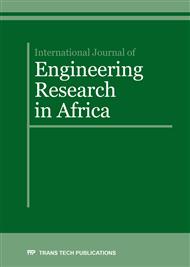p.1
p.11
p.20
p.27
p.36
p.51
p.60
p.76
p.87
Corrosion Susceptibility of a 0.35%C Steel in Seawater Electrolyte Using the Electrochemical Method
Abstract:
The Tafel extrapolation and linear polarization methods were used as effective measures for determining the corrosion susceptibility of a spheroidized 0.35%C steel with sea water as the electrolyte. Eight pieces of steel were machined to length 5mm by 10mm in diameter. Two pieces each were heat treated at 600°C, 700°C and 800°C respectively and two pieces left as control. Electro-chemical experiments were carried out to obtain the best potential and anodic current of samples immersed in an electrolyte (seawater) at varying anodic potential of-0.7mv, -0.6mv, -0.5mv and-0.4mv respectively. The results showed that the sample with the least corrosion rate were the samples spheroidized at 700°C. They appeared to have the highest electrode potential value of-0.6mv and 800°C spheroidized samples had the least electrode potential value of-0.65mv at the end of 2000seconds respectively. From the results obtained, the samples spheroidized at 700°C appeared to be most suitable for seawater environment.
Info:
Periodical:
Pages:
20-26
Citation:
Online since:
December 2016
Authors:
Price:
Сopyright:
© 2016 Trans Tech Publications Ltd. All Rights Reserved
Share:
Citation:


